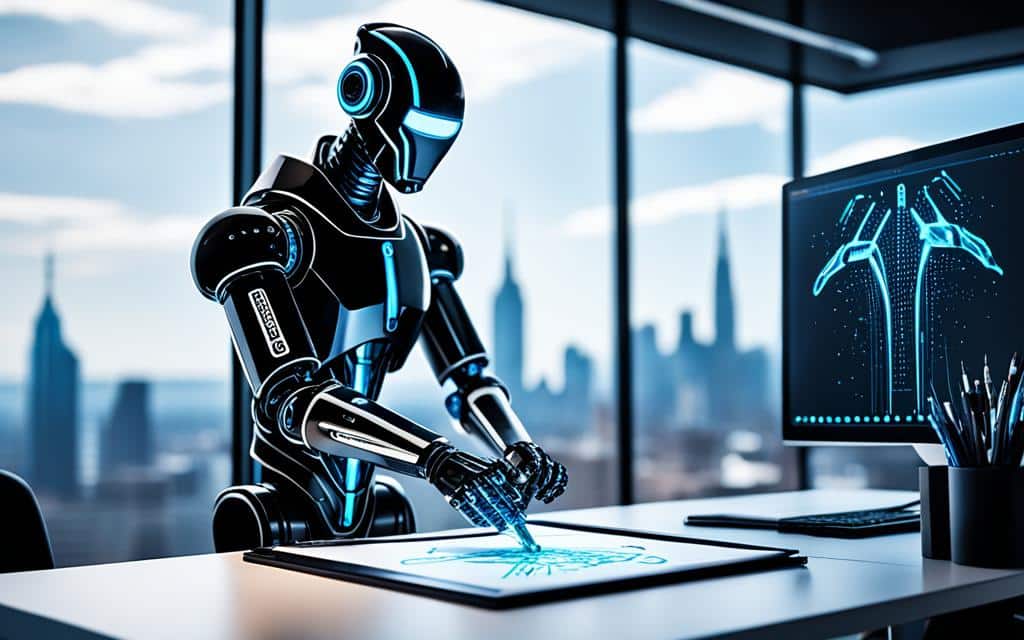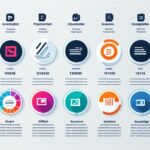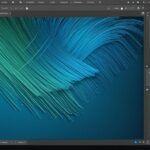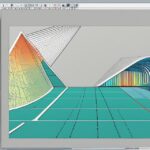Table of Contents
In recent years, Artificial Intelligence (AI) has become increasingly integrated into the world of design. AI design tools are revolutionizing the industry, offering automated content generation, enhanced creativity, personalization, improved image editing, smart layouts, brand design and analysis, real-time collaboration, and accessibility. These tools analyze data, identify patterns, and generate designs based on user preferences, saving time and enhancing the overall design process. However, there are both benefits and challenges associated with the integration of AI in graphic design. Finding the right balance between utilizing AI for efficiency while maintaining the designer’s creative input is key.
Automated Content Generation
AI-powered design tools have revolutionized the design industry by introducing automated content generation through the use of generative AI tools. These advanced tools analyze vast amounts of data, understand design principles, and generate layouts, compositions, and even complete designs.
With AI algorithms at their disposal, artists can instruct the tools to create multiple design options as a first draft. These initial designs can then be refined and customized according to the artist’s vision and client’s requirements.
Tools like Stable Diffusion, DALL-E 2, Midjourney, and Adobe Firefly are examples of AI-powered design tools that significantly speed up the design process. By automating layout generation, these tools free up designers to focus on more innovative aspects of their work.
The automated content generation provided by AI-driven tools leads to more personalized and engaging visual experiences. Designers can now create designs that are tailored to specific target audiences, resulting in improved user engagement and satisfaction.
Overall, the integration of AI-powered design tools and automated layout generation has enhanced the creativity in design by streamlining the design process and providing designers with more time to explore innovative ideas.
The Benefits of AI-Powered Design Tools
- Efficient and time-saving: AI algorithms can generate multiple design options quickly, reducing the time spent on initial design iterations.
- Enhanced customization: Designers can refine and customize AI-generated designs to align with their vision and client’s requirements.
- Improved personalization: AI-powered tools enable designers to create designs that are tailored to specific target audiences, resulting in more engaging visual experiences.
- Increased productivity: By automating layout generation, designers can focus on more innovative aspects of their work, boosting productivity.
AI-powered design tools have revolutionized the way designers work, empowering them to create visually stunning and personalized designs with greater efficiency and creativity.
Enhanced Creativity
AI algorithms can serve as valuable collaborators for designers, providing suggestions and ideas they might not have considered. By analyzing a vast library of design elements, styles, and trends, AI can offer valuable insights and inspiration, helping designers explore new concepts and push the boundaries of their creativity. For example, AI-powered tools can generate different versions of a logo design, providing designers with a valuable source of inspiration. AI’s role in enhancing creativity lies in its ability to analyze and present designers with a wide range of design possibilities, sparking new ideas and promoting innovative thinking.
Designers can benefit from the collaboration with AI algorithms by gaining access to a wealth of design inspiration that can push their creative boundaries. AI can analyze various design elements, styles, and trends to generate valuable insights that designers may not have explored on their own. By presenting designers with diverse design possibilities, AI encourages them to think outside the box and explore new concepts. This collaboration between human creativity and AI algorithms results in a fusion of originality and analytical thinking, leading to innovative and boundary-pushing designs.
“AI algorithms provide designers with fresh perspectives and ideas, enabling them to think beyond their usual creative process. By analyzing a vast array of design elements, AI constantly pushes designers to explore different directions and invent new possibilities. This collaboration of human creativity and AI intelligence acts as a catalyst for innovation in the design industry.”
Incorporating AI algorithms into the design process not only enhances the speed and efficiency of design creation but also opens up new avenues for creativity. By harnessing the power of AI, designers can expand their design horizons, draw inspiration from vast design libraries, and stay at the forefront of emerging design trends.
Benefits of AI in Enhancing Creativity
- Access to a wide range of design inspiration and ideas
- Exploration of new design concepts and possibilities
- Promotion of innovative thinking and pushing creative boundaries
- Enhanced efficiency in the design process
- Combining human creativity with AI intelligence for unique and impactful designs
| AI Algorithm | Impact on Enhancing Creativity |
|---|---|
| Content Creation | Generates automated ideas and suggestions, saving time and expanding creative possibilities |
| Style Transfer | Applies artistic styles from a range of design genres to inspire new combinations and aesthetics |
| Trend Analysis | Identifies emerging design trends and provides designers with insights for innovative designs |
| Image Recognition | Offers visual inspiration through analysis of diverse image collections and styles |
| Collaborative Design | Fosters creativity through interdisciplinary collaboration and exchange of ideas |
Personalization
In the ever-evolving world of graphic design, personalization plays a pivotal role in capturing the attention and loyalty of users. By harnessing the power of AI analysis, designers can leverage user behavior, preferences, and demographics to create truly bespoke and personalized designs.
Through the use of AI algorithms, website interfaces, layouts, and color schemes can be dynamically adjusted based on user interactions in real-time. This level of personalization creates a more immersive and user-centric experience, captivating users and inviting them to further engage with the design.
AI’s ability to generate data-driven insights equips designers with valuable information that allows them to offer tailored solutions. By understanding the individual needs and preferences of users, designers can create designs that resonate on a personal level, fostering brand loyalty and long-term engagement.
In summary, by harnessing the power of AI analysis, designers can create personalized designs that cater to the unique preferences and behaviors of individual users or target audiences. This level of personalization not only enhances the user experience but also strengthens brand engagement and loyalty.
| Benefits of AI-powered Personalization | Challenges of AI-powered Personalization |
|---|---|
|
|
“Personalization is the key to creating designs that truly resonate with users and drive brand engagement. By harnessing the power of AI analysis, designers can unlock endless possibilities for crafting tailored and immersive experiences.”
Improved Image Editing
AI-powered image editing tools have revolutionized the way designers enhance and retouch images. With the help of tools like Canva and MS Designer, designers can automate tedious tasks, saving significant time and effort in the editing process. These AI-powered tools not only streamline the workflow but also provide intelligent suggestions for improving images and removing imperfections, ensuring high-quality results.
One of the notable features of these AI-powered image editing tools is their ability to upscale low-resolution images while maintaining visual integrity. This functionality is particularly valuable for projects involving print media or large-scale graphics, where image quality is crucial. Designers can now confidently work with low-resolution images, relying on AI algorithms to enhance them without sacrificing clarity or sharpness.
“AI-powered image editing tools have transformed the way designers approach image enhancement. These tools save time, improve efficiency, and offer intelligent suggestions that enhance the overall quality of the editing process.”
By leveraging AI-powered image editing tools, designers can focus more on the creative aspects of their work while leaving repetitive tasks in the capable hands of AI algorithms. The time-saving nature of these tools allows designers to allocate more time to ideation, experimentation, and refining their design concepts, resulting in visually stunning and refined designs.
Smart Layouts
In today’s digital landscape, creating visually appealing designs that seamlessly adapt to different screen sizes and platforms is crucial. With the help of AI optimization, designers can enhance the responsiveness and cross-platform compatibility of their layouts, ensuring a consistent user experience.
AI-driven tools offer the capability to automatically optimize layouts based on the device and screen size, making them responsive and visually appealing. This means that whether a user accesses a website on a desktop, tablet, or smartphone, the content will adapt and fit perfectly on their screen. This responsive design approach not only improves the overall user experience but also reduces the need for manual adjustments, saving designers valuable time and effort.
By leveraging AI optimization, designers can focus on creating compelling content and user-friendly interfaces, knowing that their layouts will adapt seamlessly to various devices and platforms. Whether it’s a website, mobile application, or digital marketing material, AI-powered tools ensure that the design remains visually consistent, regardless of the user’s chosen device.
Benefits of AI Optimization:
- Enhanced user experience: Smart layouts ensure that content is easily accessible and readable on any device, improving user engagement and satisfaction.
- Time-saving: Automation of layout optimization reduces the manual work required for adapting designs to different screen sizes, allowing designers to focus on the creative aspects of their work.
- Consistent branding: AI optimization helps maintain a consistent brand image and visual identity across different platforms, reinforcing brand recognition and trust.
“AI optimization enables designers to create designs that look visually appealing, regardless of the device or platform.” – Design Expert
By embracing AI optimization in design, professionals can ensure that their creations are not only aesthetically pleasing but also fully optimized for an increasingly diverse range of devices and platforms. This approach allows designers to deliver exceptional user experiences, increase engagement, and drive business results.
| Benefits of AI Optimization | Examples |
|---|---|
| Enhanced user experience | Improved navigation, readability, and accessibility on different devices. |
| Time-saving | Automated adjustments for various screen sizes, eliminating the need for manual resizing. |
| Consistent branding | Uniform visual presentation and brand recognition across different platforms. |
Brand Design and Analysis
In the world of design, the role of Artificial Intelligence (AI) goes beyond automation and optimization. With advanced AI algorithms and data analysis, AI-powered tools are now capable of assisting designers in creating brand designs that resonate with target audiences. By harnessing the power of AI-driven brand design, businesses can effectively communicate their brand identity and values to their customers.
One of the key advantages of AI in brand design is its ability to analyze user preferences and market trends. By collecting and processing vast amounts of data, AI algorithms can detect patterns, identify popular design choices, and recommend brand elements that align with a brand’s personality and values. This data-driven approach ensures that the design choices are in line with market trends, allowing businesses to stay relevant and appealing to their target audience.
Furthermore, AI can also analyze the performance of various brand elements over time. By monitoring customer engagement, feedback, and conversion rates, AI can provide valuable insights to designers and marketers. This feedback helps businesses identify areas for improvement and make data-informed decisions for continuous brand enhancement.
The continuous improvement of a brand’s visual identity is essential in a rapidly evolving market. By leveraging AI-driven brand design and analysis, businesses can adapt to changing market trends and customer preferences. This proactive approach allows brands to stay ahead of the competition and maintain a strong presence in the market.
Overall, AI-driven brand design and analysis offer businesses the opportunity to create visually appealing and impactful brand identities. By harnessing the power of AI algorithms, businesses can effectively communicate their brand values, stay relevant in the market, and continuously improve their brand presence.
Conclusion
Integration of AI in graphic design offers numerous benefits and poses unique challenges to the industry. By automating repetitive tasks, AI enhances efficiency, streamlines workflows, and ensures consistent quality. Additionally, AI-powered tools boost creativity by providing inspiration and generating design options. Personalization is also a key advantage, as AI can analyze user behavior and demographics to create tailored designs for individual users or target audiences.
However, there are concerns surrounding job displacement, potential loss of creativity and originality, ethical considerations, and the need for designers to adapt and enhance their skills. While AI revolutionizes certain aspects of graphic design, human designers possess essential qualities such as empathy, critical thinking, and ethics that set them apart. Therefore, striking a balance between leveraging AI for efficiency and preserving human creativity is crucial for the future of graphic design.
Ultimately, the integration of AI in the graphic design process represents a powerful tool that can benefit designers and improve overall outcomes. By embracing AI technology, designers can harness its capabilities to streamline their workflows, unlock new ideas, and engage with audiences on a more personalized level. As the industry evolves, it is important for designers to adapt and find innovative ways to merge AI integration with their own creative expertise, ensuring that human creativity remains at the forefront of graphic design.
FAQ
How does AI impact design tools and creativity?
AI design tools revolutionize the industry by offering automated content generation, enhanced creativity, personalization, improved image editing, smart layouts, brand design and analysis, real-time collaboration, and accessibility.
What can AI-powered design tools do?
AI-powered design tools have the ability to analyze data, understand design principles, and generate layouts, compositions, and entire designs. Artists can instruct AI algorithms to create multiple design options as a first draft, which can then be refined and customized according to the artist’s vision and client’s requirements.
How does AI enhance creativity in design?
AI algorithms analyze a vast library of design elements, styles, and trends, offering valuable insights and inspiration. They can generate different versions of a logo design, providing designers with a valuable source of inspiration. AI sparks new ideas and promotes innovative thinking by presenting designers with a wide range of design possibilities.
How does AI contribute to personalization in graphic design?
AI can analyze user behavior, preferences, and demographics to create designs tailored specifically to individual users or target audiences. It dynamically adjusts website interfaces, layouts, and color schemes based on user interactions in real-time, creating a more immersive and user-centric experience.
What benefits do AI-powered image editing tools offer?
AI-powered image editing tools automate tasks such as retouching and enhancing images, saving designers significant time and effort. They can also upscale low-resolution images while maintaining visual integrity, making them valuable for projects involving print media or large-scale graphics.
How does AI optimize layouts in graphic design?
AI-driven tools can automatically optimize layouts, making them responsive and ensuring a consistent user experience across various screen sizes and formats. This capability improves the visual appeal of designs and enhances the user’s interaction with the content.
How can AI contribute to brand design and analysis?
AI algorithms can analyze user preferences and market trends to recommend design choices that align with a brand’s personality and values. They can also analyze the performance of various brand elements over time, providing valuable feedback to designers and marketers for continuous improvement.
What is the impact of AI integration in graphic design?
AI integration enhances efficiency, creativity, personalization, and collaboration in the design process. It automates repetitive tasks, streamlines workflows, and ensures consistency and quality. However, there are concerns about job displacement, loss of creativity and originality, ethical considerations, and the need for designers to adapt and upskill.













